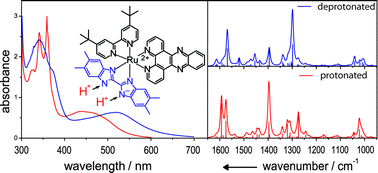A systematic DFT/(resonance) Raman spectroscopic study of the protonation/deprotonation induced changes in the vibrational spectra of a trisheteroleptic ruthenium complex [(tbbpy)Ru(II)(tmbibzimH2)(dppz)]2+ (tbbpy = 4,4′-di-tert-butyl-2,2′-bipyridine, tmbibzim = 5,5′,6,6′-tetra-methyl-2,2′-bibenzimidazole and dppz = dipyrido[3,2-a:2′,3,3′-c]phenazine) is presented. This molecular system combines the pH sensitivity of ruthenium bibenzimidazole systems with the light-switch properties of ruthenium dppz dyes. The results show that the protonation state of the tmbibzim ligand mainly impacts the geometry and the frequencies of the vibrational modes of the tmbibzim ligand itself. Here, band shifts up to 70 cm−1 are observed. The tbbpy and dppz ligand structures remain unaffected. However, the signals of the dppz and tbbpy modes shift upon protonation slightly to higher wavenumbers by 2–3 cm−1, which is assigned to a stronger π-backbonding in the deprotonated form of the complex. The results of the DFT calculations were used to perform a normal mode analysis of the resonance Raman spectra of the differently protonated forms in solution upon excitation into the metal-to-ligand charge transfer band. The resonance Raman spectra lack protonation dependence of their spectral features, which is an indicator that no tmbibzim modes are enhanced in the resonance Raman spectra and no photoinduced metal-to-ligand charge transfer from the central ruthenium ion to tmbibzim localized acceptor orbitals occurs.

You have access to this article
 Please wait while we load your content...
Something went wrong. Try again?
Please wait while we load your content...
Something went wrong. Try again?


 Please wait while we load your content...
Please wait while we load your content...